Early this week, ranchers and beef supporters gathered in Alamogordo, New Mexico, to protest the U.S. Forest Service’s mandated reductions of the Goss Family Ranch‘s herd from more than 400 head to barely 100 head of cattle (a 75 percent reduction) within the year — a move that is based on current federal documents but rooted in a generations-long struggle between these ranchers and the government.
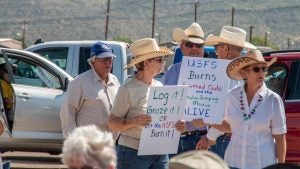
On Friday, July 8, 2022, the USFS issued a suspension to ranch owners Spike and Kelly Goss for overutilization and non-compliance with Annual Operating Instructions. The ranchers, however, blame the large, allegedly mismanaged elk ranging in the district for the overgrazing of forage.
The AOI is now forcing the Goss family to reduce its herd of cattle from 412 head to just 103 head within a year — threatening the livelihood of a family ranch that has been raising cattle in the Sacramento Mountains for over 100 years.
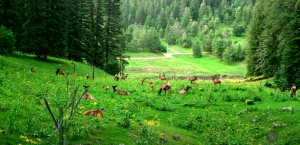
“My family, they’re the best people I know,” said Kara Cochran, the ranch owners’ daughter. “God-fearing, nature-loving; I don’t care what people say about us hating animals — that’s not true. Ranchers are the best stewards of the land that you will ever meet. Our livelihood depends on it.”
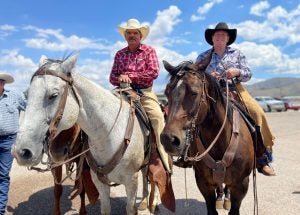
The suspension followed a biological opinion (a document assessing impacts on conservation measures and wildlife) that was completed by the U.S. Fish and Wildlife Service for ongoing livestock management on the Sacramento and Dry Canyon Allotments. It reduced livestock numbers on the 100,000-acre allotment down to 330 head within 30 days of the letter issued by the USFS on May 18, 2021.
»Related: $19M research project explores grazing management impact on soil health
The Goss Family Ranch’s battles with the USFS trace back decades. In 1885, Ananias Green moved from Texas to the Sacramento Mountains to raise cattle. His grandson, Spike, currently holds the permits to the Sacramento Allotment of the Lincoln National Forest. Since the late 1900s, the ranch has faced USFS-mandated herd reductions, allotment closures, and incidences of cattle being fenced off of water to protect endangered species.
Despite the USFS’s concern for overgrazing by cattle, the ranchers argue that ATVs and UTVs are commonplace on the Lincoln National Forest and that all-terrain vehicles are detrimental to grazing lands and habitat.
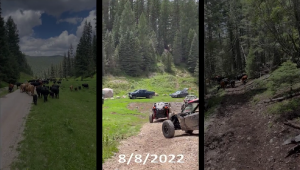
At the protest, Otero County Commissioner Vickie Marquardt, New Mexico Cattle Growers’ Association board member Gary Stone, Carolyn Miller Nelson with Ranchers Have Rights, and Cochran spoke out against the Forest Service’s actions, calling for protection from the economic disruption that could close down their ranch.
Cochran said, “Thirty years of going through this has been heartbreaking. If my dad died of a heart attack tomorrow, I would accuse the Forest Service of murder because of the stress they have put on him.”
New Mexico Congresswoman Yvette Herrell also spoke out, saying, “An attack from the federal government is an attack on the Western way of life.”
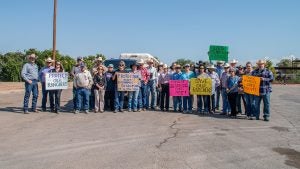
In New Mexico, ranchers convey water rights at the time of sale — when the Goss family acquired sole ownership of the SGA in 1997, deeds and appropriations dating back to ancestor Eli Reynold’s ownership of the land in 1896 were passed on. Despite this, the USFS continued to fence cattle off from water sources to protect multiple endangered species.
In 2004 the family filed a lawsuit against the USFS after their thirsty cattle were fenced off water on the Sacramento Grazing Association allotments. The case was settled in 2017 after a determination that the federal government violated the Sacramento Grazing Association’s rights to the beneficial use of stock water in the Lincoln National Forest under New Mexico law.
The New Mexico Constitution recognizes water rights vested before March 19, 1907, acquired through common law prior-appropriation. Existing water rights for beneficial purpose are recognized — and the court documents read, “The United States Forest Service (‘USFS’) has a responsibility to manage national forests, including the habitat of endangered species. But a small, family-owned cattle ranch should not be forced to ‘bear’ the entire financial burden of the USFS’s management choices, where they interfere with property rights, recognized by state law.”
In 1985, the USFS began erecting “exclosures” around water sources to protect endangered species, including the Sacramento Mountain Thistle and the Southwestern Prickly Poppy.
In 1995, the Forest Service warned the Goss family about violations of the AOP. It issued warnings after that, eventually reducing the number of cattle on the allotment from 553 to 428 in 2000. Later that summer, the number of cattle was again reduced, this time to 330.
The family argues that the USFS uses inaccurate data collection measures to determine their AOIs. Cochran detailed an incident where range specialists were collecting grass samples and intentionally measuring areas covered with gopher mounds. She said, “These types of biased data gathering — this is the kind of information they’ve been using to say that they scientifically need to remove cattle. It’s wrong, and it’s not working. If they wanted to protect the endangered species like they claim all of this is for, they would realize that the state of forests is a nightmare and recognize how many forests, animals, and endangered species are gone because of the catastrophic wildfires we have now. These practices started 30 years ago.”
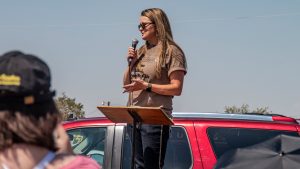
The Homestead Act allowed for 640 acres for settlement; however, in the West’s arid conditions, 640 acres did not allow the resources to farm, ranch, or support a family. This situation was remedied by attaching permitted land next to the homestead acres — enough to support a family. Documents from 1897 where Arizonans were taxed on Possessory Rights based on the appurtenances (attached lands) support this claim.
In 1905, the forests were permitted to protect the land for beneficial uses and moved management from the U.S. Department of the Interior to the U.S. Department of Agriculture. Nelson from Ranchers Have Rights argues that since the Interior does not manage forests, it should not mandate how they are managed based on endangered species chosen outside of the USDA’s purview.
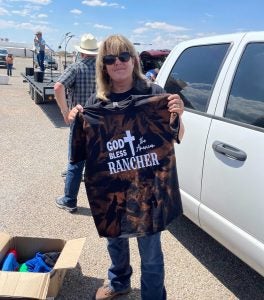
Nelson said, “We should ask where the protection is from economic destruction. Why is the Secretary of the Interior coming onto the Secretary of Ag’s responsibility and running ranchers off? They already did that. One hundred years ago, they did that — and it did not work. Why are they doing that again, and why is it legal? Why is it right?”


